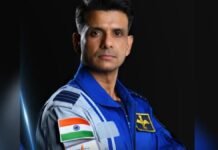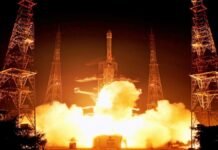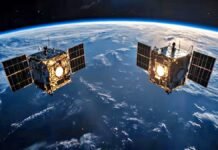
Key Points
- ISRO’s PSLV-C61 mission failed to deploy the EOS-09 satellite due to a technical issue in the third stage.
- EOS-09 was designed to enhance India’s remote sensing capabilities, serving as a twin to the earlier EOS-04.
- ISRO chief V Narayanan assured a thorough analysis and promised a swift comeback.
- This was ISRO’s 101st launch attempt, aiming to place EOS-09 in a Sun Synchronous Polar Orbit (SSPO).
Sriharikota, Andhra Pradesh: The Indian Space Research Organisation (ISRO) faced a rare setback on Sunday as its 101st mission, the launch of PSLV-C61 carrying the Earth Observation Satellite-09 (EOS-09), failed to achieve its intended orbit due to a technical issue during the rocket’s third stage.
Mission Overview: What Was at Stake?
The PSLV-C61 was launched from the Satish Dhawan Space Centre in Sriharikota, carrying the EOS-09 satellite. EOS-09, a twin of the earlier EOS-04, was designed to boost India’s remote sensing data capabilities. The satellite was intended to serve a wide range of operational users, providing frequent and high-quality Earth observation data for applications such as agriculture, forestry, disaster management, and urban planning.
What Went Wrong?
ISRO provided an update on social media platform X (formerly Twitter), stating:
“Today the 101st launch attempt was made, the performance of PSLV-C61 was normal till the second stage. The mission could not be completed due to observation in the third stage.”
The PSLV-C61’s complex flight sequence involves multiple stages, starting from the ignition of the first stage (PS1) and its strap-on motors (PSOM), followed by the separation of various segments, and culminating in the deployment of the satellite into its designated Sun Synchronous Polar Orbit (SSPO). However, the anomaly during the third stage prevented the rocket from reaching the required velocity and altitude for satellite deployment.
ISRO’s Response: “We Will Be Back”
Addressing the ISRO team and the nation, ISRO chief V Narayanan acknowledged the setback and praised the efforts of the scientists involved.
“During the functioning of the third stage, we observed a technical issue and the mission could not be completed. After a detailed analysis, we will be back stronger,” Narayanan assured.
Significance of EOS-09 and the Mission
EOS-09 was a critical part of India’s effort to strengthen its Earth observation fleet. Its data was expected to support operational users in multiple sectors, improving the frequency and quality of observations for both civilian and strategic applications.
This mission was ISRO’s 101st launch, marking a significant milestone in India’s space journey. Despite the setback, ISRO remains one of the world’s most reliable space agencies, with a history of successful missions and rapid recoveries from occasional failures.
What’s Next for ISRO?
ISRO will conduct a thorough investigation into the third-stage anomaly before announcing its next steps. The agency’s leadership has reiterated its commitment to learning from this experience and returning to the launch pad with renewed vigor.



















































